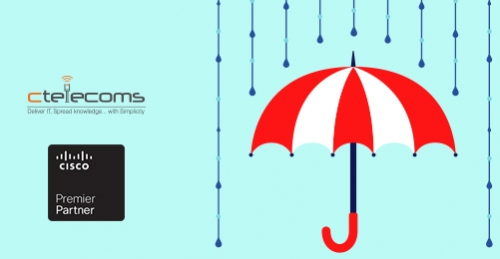

2020/09/27 IT & Cyber-Security Solutions 3404 visit(s)


Managing the security of a multi-vendor environment has become more challenging than ever now with remote working becoming the norm.
The reality is that your team doesn’t need any more alarm bells. They need the context behind each alert, so they can better prioritize, understand, and remediate issues. This is about extracting more insight from the cybersecurity tools already at hand. It’s about enabling your devices, cloud services, and network infrastructure to share data and enforce policies regardless of location. It’s about really understanding what is going on so that you can make decisions that are appropriate and timely.
As a premier Cisco partner in Saudi Arabia, Ctelecoms is committed to sharing and strengthening contextual intelligence across your security stacks. With bi-directional APIs, programmatic sharing of contextual threat intelligence, and anycast routing technologies, we’ve made it easier to get the most out of your security infrastructure quickly and efficiently.
Here are seven things you can do with Cisco Umbrella to extend your cybersecurity abilities:
We help you leverage the bi-directional APIs of Cisco Umbrella DNS-layer security to secure devices and sites beyond your perimeter. This begins by programmatically converting local threat detection and intelligence from your existing systems into global threat prevention to protect your infrastructure and assets wherever they are.
Embrace the principles of integration, intelligence, and automation to benefit from a portfolio of solutions that work together. This integrated portfolio helps you enforce policies, protect and control cloud apps, and keep your network and endpoints safe from threats.
More complete insights don’t come from one source. Data needs to flow from a 360-degree view of your environment. Cisco Umbrella employs a bi-directional approach that leverages not only threat intelligence from the global Umbrella security network, but also collects insights from across your networks and devices. This back-and-forth knowledge enriches security events with threat intelligence about the domains, IPs, and file hashes used in attacks, helping to pinpoint attackers’ infrastructures, and predict future threats.
Cisco Umbrella’s threat intelligence uncovers and blocks a broad spectrum of malicious domains, IPs, URLs, and files. Umbrella uses threat data from Cisco Talos, one of the largest threat intelligence teams in the world. This scale, combined with data from statistical and machine learning models, makes Umbrella’s threat intelligence one of the most effective sources for anti-virus blocking in the world.2
Cisco Umbrella extends your protection to guests by enforcing network security and content filtering at the DNS layer. Umbrella uses anycast routing technology, which means you need to deal with only one IP address for your entire enterprise — making it easy to secure guest Wi-Fi in a few steps.
Umbrella’s DNS-layer security uses anycast routing in which every data center announces the same IP address, so requests are transparently sent to the fastest available with automated failover. This allows us to route traffic to the fastest server at the time, for the shortest path for every connection. Further, peering relationships provide shortcuts between networks, which enables us to resolve requests faster — and boost internet speed.
Cisco Umbrella’s anycast routing infrastructure not only means speed. It also delivers a global, self-healing network that can handle infrastructure disruptions — natural disasters, equipment failure, or maintenance — without passing on the disruption to you.
Ctelecoms is dedicated to helping you do more with your security infrastructure so that your organization, regardless of size, can focus on the business at hand – all with Cisco Umbrella. Get started today!
Resource: https://umbrella.cisco.com/